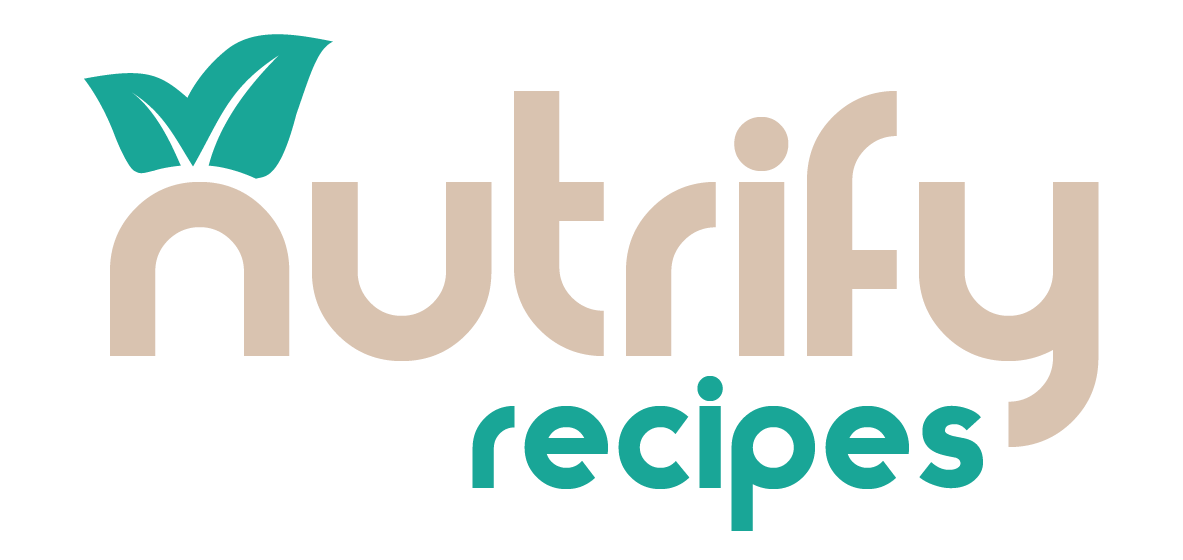Southern cornbread is a cornerstone of classic American comfort food, celebrated for its golden crust, fluffy interior, and rich flavor. This Southern cornbread recipe has roots deeply embedded in Southern cuisine, making it a staple on dinner tables for generations. Whether it’s served as a side dish to hearty stews or enjoyed on its own with a dollop of butter, this dish epitomizes warmth, tradition, and hospitality.
But what makes this recipe so unique? For one, this authentic cornbread recipe is traditionally made without sugar, relying instead on the natural sweetness of cornmeal to shine. Additionally, it incorporates buttermilk for a tangy edge and is cooked in a sizzling hot cast-iron skillet, achieving its signature crispy edges.
In this guide, you’ll learn every step of preparing the perfect Southern cornbread, from choosing the best ingredients to exploring delicious variations and serving ideas. This easy-to-follow homemade cornbread recipe ensures your dish turns out perfectly every time.
Table of contents
Ingredients Overview
When it comes to Southern cornbread, the quality of the ingredients plays a pivotal role in achieving that authentic flavor and texture. Let’s dive into the essentials and the tools you’ll need to create this beloved dish.
Traditional vs. Modern IngredientsTraditional vs. Modern Ingredients
The success of any Southern cornbread recipe begins with the right ingredients. Traditionally, this authentic cornbread recipe relies on simple staples like stone-ground cornmeal, buttermilk, and eggs. These ingredients form the foundation of the dish, ensuring its rich flavor and satisfying texture.
For a true homemade cornbread recipe, it’s essential to focus on the natural flavors of cornmeal. While modern variations may include sugar or flour for a softer texture, purists argue that an authentic Southern cornbread recipe should be savory and rely solely on cornmeal’s natural sweetness.
Importance of Buttermilk and Cornmeal
When making a Southern cornbread recipe, the choice of buttermilk and cornmeal is crucial. Buttermilk not only adds a tangy flavor but also creates a tender texture, making it a must-have ingredient in any homemade cornbread recipe. Likewise, stone-ground cornmeal brings a hearty texture and a rich, corn-forward taste that sets this dish apart.
Tools Required for Preparation
To make authentic Southern cornbread, the right tools are just as important as the ingredients.
- Cast-Iron Skillet: A seasoned cast-iron skillet is key to achieving the iconic crispy crust.
- Mixing Bowls: You’ll need separate bowls for wet and dry ingredients to ensure even mixing.
- Whisk or Fork: For mixing the batter without overworking it.
- Measuring Cups and Spoons: Precision is vital to get the right balance of ingredients.
Pro Tip: Preheating the cast-iron skillet in the oven or on the stovetop before pouring in the batter is crucial. This step creates the crispy edges that define Southern cornbread.
Let’s improve keyphrase density further in Step-by-Step Recipe and Serving Ideas and Pairings sections while maintaining readability.
Step-by-Step Recipe
Making the perfect Southern cornbread recipe is simpler than you might think. By following these steps, you can achieve a crispy crust and a fluffy, moist interior every time. This homemade cornbread recipe relies on traditional techniques and quality ingredients, ensuring authentic flavor.
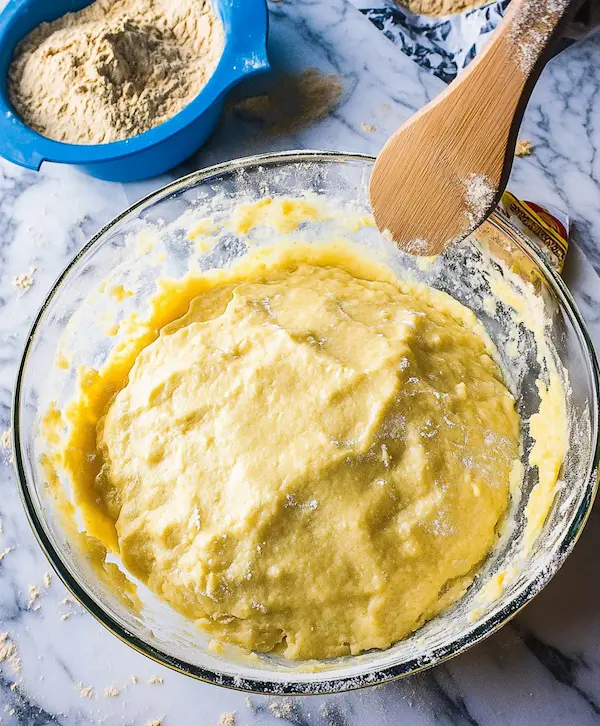
Preparation Tips
Before starting your Southern cornbread recipe, it’s important to preheat your oven to 425°F and place your cast-iron skillet inside. This ensures your cornbread will develop the crispy edges that define an authentic Southern cornbread recipe.
Bringing your ingredients to room temperature is another essential step for any homemade cornbread recipe. It allows the batter to mix smoothly and bake evenly, delivering a perfect result.
Mixing the Batter
The batter for this Southern cornbread recipe comes together quickly with a mix of dry and wet ingredients. Combine stone-ground cornmeal, buttermilk, and eggs, then pour the batter into a hot skillet. This traditional technique ensures your homemade cornbread recipe bakes to golden perfection.
By taking these steps early, you’ll avoid common issues like sticking or uneven baking.
Mixing the Batter
Here’s how to prepare the batter for your Southern cornbread:
Ingredients:
- 1 ½ cups stone-ground cornmeal
- ½ cup all-purpose flour (optional, for a lighter texture)
- 1 teaspoon baking soda
- 1 teaspoon salt
- 1 large egg
- 1 ¾ cups buttermilk
- 3 tablespoons bacon grease or vegetable oil
Instructions:
- Combine the Dry Ingredients: In a large bowl, whisk together the cornmeal, flour (if using), baking soda, and salt. Mixing these well ensures even flavor throughout the batter.
- Prepare the Wet Ingredients: Crack the egg into a medium bowl and whisk it lightly. Then, add the buttermilk to the bowl and mix until everything is smooth.
- Mix the Wet and Dry: Slowly pour the wet mixture into the dry ingredients. Stir gently until just combined. It’s important not to overmix because doing so can make your cornbread dense instead of fluffy.
As you mix, remember that the batter should be thick but still pourable. If it feels too dry, add a little more buttermilk, one tablespoon at a time.
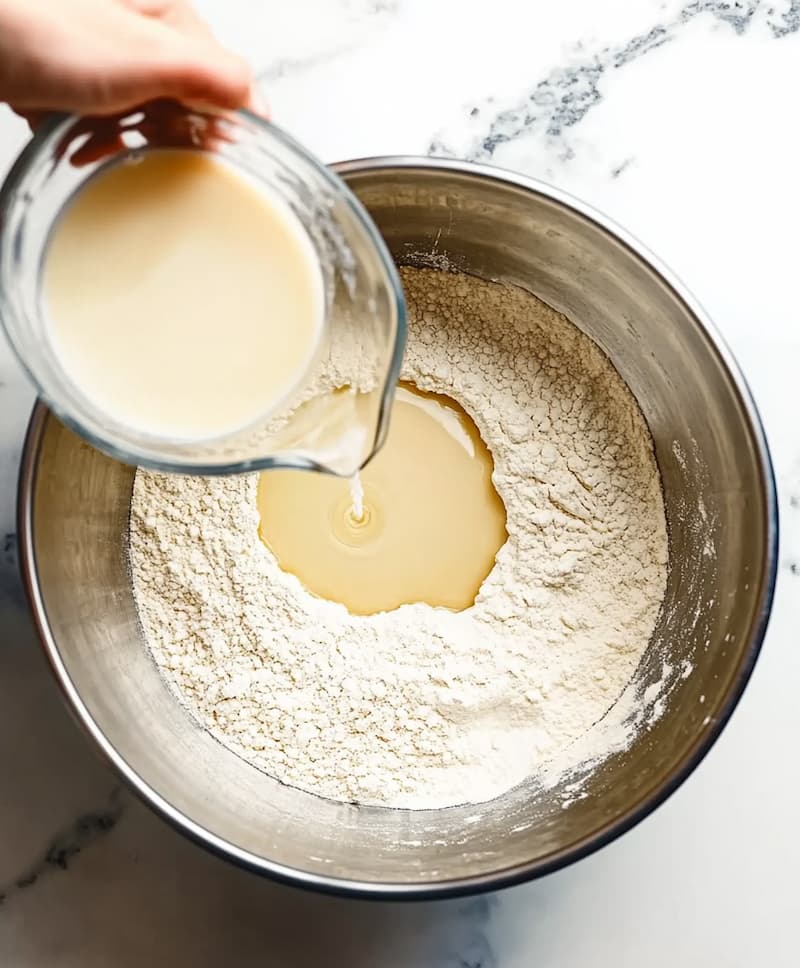
Baking the Cornbread
Now that your batter is ready, it’s time to bake:
- Heat the Skillet: Remove the preheated skillet from the oven carefully, as it will be extremely hot. Swirl the oil or bacon grease inside to coat the bottom and sides.
- Pour in the Batter: Gently pour the batter into the hot skillet. You should hear a satisfying sizzle as the batter hits the pan. This step starts creating the crispy edges immediately.
- Bake to Perfection: Place the skillet back into the oven and bake for 20-25 minutes. Keep an eye on the top—it should turn a deep golden color and feel firm to the touch.
- Test for Doneness: Insert a toothpick into the center. If it comes out clean, your cornbread is ready to come out of the oven.
After baking, let the cornbread cool in the skillet for 5-10 minutes. This resting time makes it easier to slice and serve.
Variations of Southern Cornbread
Southern cornbread is a versatile dish that can be customized in countless ways. From regional differences to dietary adaptations, there’s a variation for everyone. Let’s explore some popular twists on this classic recipe.
Sweet vs. Savory Cornbread
One of the most debated topics among cornbread enthusiasts is whether it should be sweet or savory.
- Savory Cornbread: Traditional Southern cornbread is savory, with no sugar added. It relies on the natural sweetness of cornmeal and the richness of buttermilk. This version pairs beautifully with hearty soups, stews, or chili.
- Sweet Cornbread: Adding sugar (usually 2-4 tablespoons) gives the bread a hint of sweetness, which appeals to those who enjoy cornbread as a standalone snack or a dessert-like treat. Honey or maple syrup can also be used for a natural sweetener.
While sweet cornbread is more common in other parts of the United States, it’s easy to adjust the recipe to suit your taste by experimenting with the amount of sugar.
Gluten-Free Cornbread
For those with gluten sensitivities or allergies, creating a gluten-free version is straightforward:
- Replace the all-purpose flour with a gluten-free flour blend.
- Alternatively, use only stone-ground cornmeal for a fully gluten-free option. This creates a denser texture, but the flavor remains authentic.
Pro Tip: Check your cornmeal packaging to ensure it’s labeled gluten-free, as cross-contamination can occur during processing.
Vegan Cornbread
Making Southern cornbread vegan-friendly is also possible with a few simple swaps:
- Replace Buttermilk: Mix 1 cup of plant-based milk (such as almond or soy milk) with 1 tablespoon of vinegar or lemon juice. Let it sit for 5 minutes to mimic the tanginess of buttermilk.
- Egg Substitutes: Use a flax egg (1 tablespoon of ground flaxseed mixed with 3 tablespoons of water) or a commercial egg replacer.
The result is a dairy-free and egg-free cornbread that’s just as moist and flavorful as the original.
Add-Ins for Extra Flavor
For a fun twist, consider adding ingredients to the batter to suit your preferences:
- Cheese: Shredded cheddar or pepper jack can be folded into the batter for a cheesy cornbread.
- Jalapeños: Diced jalapeños add a spicy kick that complements savory dishes.
- Bacon: Crumbled, cooked bacon creates a smoky flavor that’s irresistible.
- Corn Kernels: Add fresh, frozen, or canned (drained) corn for bursts of sweetness and texture.
These add-ins elevate your cornbread, making it suitable for potlucks, picnics, or family gatherings.
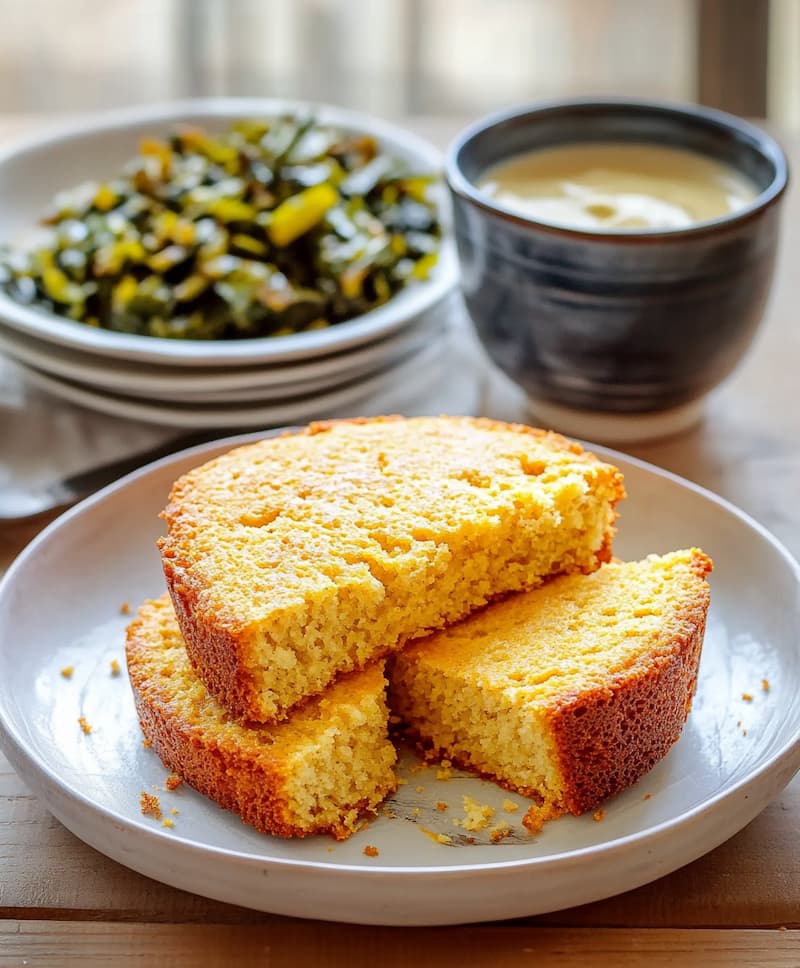
Regional Variations
Different parts of the South have their own unique takes on cornbread:
- Hot Water Cornbread: A simple, fried version made with just cornmeal, hot water, and salt. This cornbread is crispy on the outside and soft inside.
- Cracklin’ Cornbread: Incorporates pieces of pork cracklings (fried pork fat) into the batter for a rich, savory flavor.
- Corn Pone: A denser, unleavened variation baked or fried, often enjoyed with molasses.
Each of these variations showcases the creativity and adaptability of Southern cooking.
Serving Ideas and Pairings
Southern cornbread is as versatile as it is delicious. Whether served alongside classic Southern dishes or enjoyed on its own, there’s no shortage of ways to savor this timeless favorite. Here are some creative serving ideas and complementary pairings.
Serving Southern Cornbread
Cornbread is best served warm, straight from the skillet, to fully appreciate its crispy edges and tender interior. Here’s how to make it shine on the table:
- With Butter: Spread a generous pat of butter over a slice for a simple yet indulgent treat. For extra flair, try honey butter or herb-infused butter.
- Drizzle with Honey or Syrup: A light drizzle of honey or maple syrup adds sweetness without overpowering the natural flavors.
- Crumbled in Milk: A traditional Southern snack involves crumbling cornbread into a glass of milk or buttermilk. It’s a nostalgic and satisfying treat.
For a rustic presentation, serve the cornbread directly in the cast-iron skillet.
Pairing Cornbread with Southern Classics
Cornbread complements a variety of hearty Southern dishes. Here are some popular pairings:
- Chili: The savory, slightly tangy flavor of cornbread balances the spiciness of a rich chili.
- Barbecue: Serve cornbread as a side to smoked ribs, pulled pork, or brisket to soak up the flavorful sauces.
- Greens: Cornbread is a traditional partner for collard greens or mustard greens cooked with ham hocks.
- Beans: Whether it’s black-eyed peas, pinto beans, or a pot of red beans, cornbread provides the perfect vehicle for scooping up every bite.
- Fried Chicken: The crispy crust of cornbread pairs wonderfully with the crunch of perfectly fried chicken.
Turning Leftovers into Something New
If you have leftover cornbread, don’t let it go to waste! Here are a few creative ways to use it:
- Cornbread Croutons: Cube the leftover cornbread, toss with olive oil and seasonings, and bake until crispy. These make a delicious topping for salads or soups.
- Cornbread Stuffing: Use crumbled cornbread as a base for stuffing during holiday meals. Mix it with onions, celery, and broth for a Southern twist.
- Cornbread Pudding: Transform stale cornbread into a sweet or savory pudding by mixing it with eggs, milk, and your favorite add-ins.
- Breakfast Treat: Warm leftover cornbread, top it with butter and jam, and enjoy it with a cup of coffee.
Storing and Reheating Cornbread
To keep cornbread fresh, follow these simple storage tips:
- Room Temperature: Wrap it tightly in plastic wrap or place it in an airtight container. It will stay fresh for up to 2 days.
- Refrigeration: For longer storage, refrigerate cornbread in an airtight container for up to 5 days.
- Freezing: Wrap individual slices in plastic wrap and place them in a freezer-safe bag. Frozen cornbread can last up to 3 months.
When reheating, wrap the cornbread in foil and warm it in the oven at 350°F (175°C) for about 10 minutes. This helps retain its texture and flavor.
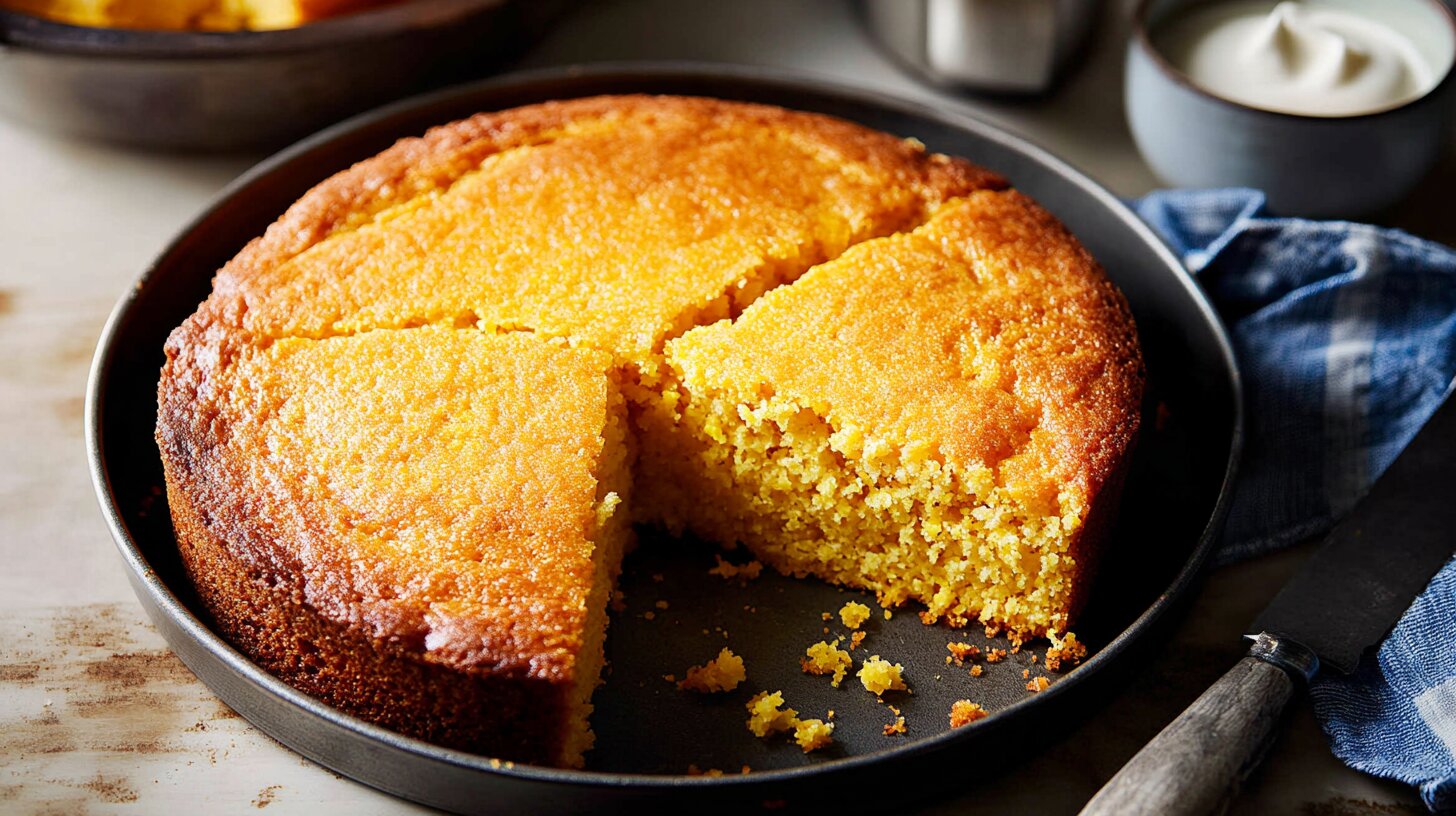
Southern Cornbread Recipe
Equipment
- Cast-Iron Skillet
Ingredients
- 1 ½ cups 225g cornmeal
- ½ cup 65g all-purpose flour
- 1 teaspoon salt
- 1 teaspoon baking soda
- 1 teaspoon baking powder
- 1 ¼ cups 300ml buttermilk (or substitute: 1 cup milk + 1 tbsp vinegar)
- 1 egg beaten
- ¼ cup 60ml melted butter or bacon drippings
- 2 tablespoons vegetable oil for the skillet
Instructions
- Preheat your oven to 450°F (230°C). Place a cast-iron skillet in the oven while it heats.
- In a bowl, whisk together cornmeal, flour, salt, baking soda, and baking powder.
- Add buttermilk, egg, and melted butter. Stir until just combined.
- Carefully remove the hot skillet from the oven and add vegetable oil. Swirl to coat the bottom.
- Pour the batter into the hot skillet (it should sizzle for a crisp crust).
- Bake for 20-25 minutes, until golden brown and a toothpick comes out clean.
- Let cool for 5 minutes, then slice and serve warm.
Notes
- For a spicier version, add diced jalapeños.
- For a sweeter version, add 1-2 tbsp of honey.
- Works well with gluten-free cornmeal for a GF version.
People also ask
To help you perfect your Southern cornbread and clear up any lingering doubts, here are answers to some common questions about the recipe.
Difference Between Cornbread and Southern Cornbread:
Cornbread is a general term for a quick bread made with cornmeal, while Southern cornbread typically has a denser, less sweet profile. Traditional Southern cornbread often omits sugar and incorporates buttermilk for a tangy flavor, with a crispy crust achieved by baking in a cast-iron skillet.
Why Southerners Don’t Put Sugar in Cornbread?
Historically, Southern cornbread was a savory dish rooted in regional tradition and affordability, as sugar was less accessible. Many Southerners maintain this practice to preserve its authenticity and traditional flavor.
Buttermilk vs. Milk in Cornbread?
Buttermilk is preferred in cornbread as it adds tanginess and reacts with baking soda to create a tender, fluffy texture. Milk can be used as a substitute, but it won’t deliver the same depth of flavor or lightness.
Adding an Extra Egg to Cornbread?
Adding an extra egg increases richness and moisture while improving the bread’s structure. It can also make the cornbread slightly more cake-like in texture.
Why is my cornbread dry?
Dry cornbread usually results from overbaking or not enough moisture in the batter. To avoid this:
- Monitor Baking Time: Check your cornbread 5 minutes before the recommended baking time ends. It should be golden brown and firm but not overcooked.
- Adjust the Liquid: If your batter feels too thick, add an extra tablespoon or two of buttermilk.
- Use a Skillet: Cooking in a cast-iron skillet retains moisture better than other pans.
Can I make cornbread without a cast-iron skillet?
Yes, you can still make great cornbread without a cast-iron skillet. Instead, use a:
- Baking Dish: A glass or ceramic dish works well, though you may not achieve the same crispy edges.
- Nonstick Pan: These are suitable for baking, but preheating the pan won’t give the same result as cast iron.
- Muffin Tin: This is a fun way to create individual portions with slightly crisp edges.
How do I prevent my cornbread from sticking to the pan?
To keep cornbread from sticking:
- Always preheat your pan before adding the batter.
- Use plenty of grease, such as vegetable oil, butter, or bacon grease, to coat the pan evenly.
- If you’re not using cast iron, line the pan with parchment paper or use a nonstick spray for added protection.
Can I substitute buttermilk with regular milk?
While buttermilk is ideal for its tangy flavor and acidity, you can substitute it if necessary:
- DIY Buttermilk: Mix 1 tablespoon of vinegar or lemon juice into 1 cup of milk. Let it sit for 5 minutes before using.
- Yogurt or Sour Cream: Thin these with a little water to match the consistency of buttermilk.
These substitutes will give you similar results without compromising texture.
What’s the difference between Northern and Southern cornbread?
The key difference lies in the flavor and texture:
- Southern Cornbread: Traditionally savory, made with little or no sugar, and relies heavily on cornmeal for a denser texture. It’s often baked in a cast-iron skillet for a crispy crust.
- Northern Cornbread: Sweeter and lighter, with a higher proportion of flour to cornmeal. It’s typically baked in a standard baking pan.
Both are delicious, but the Southern version is heartier and more rustic.
How can I make cornbread fluffier?
For lighter, fluffier cornbread:
- Add a Little Flour: A 2:1 ratio of cornmeal to all-purpose flour creates a softer texture.
- Don’t Overmix: Stir the batter just until combined to avoid overdeveloping the gluten.
- Use Fresh Ingredients: Ensure your baking soda or baking powder is fresh for proper leavening.
Can I freeze leftover cornbread?
Yes, cornbread freezes beautifully! Follow these steps for the best results:
- Let the cornbread cool completely to prevent condensation.
- Wrap individual slices tightly in plastic wrap or foil.
- Place the wrapped pieces in a freezer-safe bag or container.
To reheat, thaw at room temperature and warm in the oven at 350°F (175°C) for 10 minutes.
Final Thoughts
Mastering Southern cornbread is all about embracing simplicity and tradition. With this recipe, you’ll create a dish that’s perfect for family dinners, potlucks, or just a cozy night at home. Whether served on its own or as an accompaniment, cornbread is a versatile addition to your table. Pair it with hearty baked beans for a meal that’s sure to satisfy. For inspiration, check out The Best Sides for Baked Beans: 10 Tasty Pairings You’ll Love to complete your feast.
Enjoy the golden crust and tender crumb of this timeless Southern favorite!
